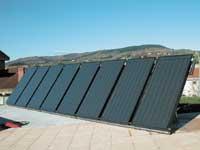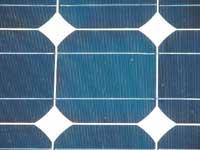Renewable Energy in Vocational Training


The new state-of-the-art building offers the possibility to learn how to install and exploit solar thermal, solar photovoltaic, geothermal and wind energy. In addition, the new building gets hot water and heating with all these energies.
Solar energy, thousand uses!
It is used for obtaining solar thermal energy. To do this, dark solar panels are placed. These panels are not photovoltaic, that is, they do not produce electricity. In fact, the only function of the panels is to collect as much heat as possible, so they are dark. In addition, these panels are oriented to the geographic south and, depending on the time of year, have a tilt change system.
This energy collected by panels is used to heat the water, which in the case of the school of Usurbil is 500 liters.
Hot water is stored in a tank located in the boiler room and then deployed from there when necessary. For example, if a class has cooled, the heating circuit that carries hot water opens and heats up.

Photovoltaic solar energy is better known. In this system, the energy of the Sun is used to generate electricity, using photovoltaic panels. This electricity produced by photovoltaic panels is injected into the grid and in return receives money for the energy supplied to the grid.
In this case also the photovoltaic panels installed in Usurbil have a tracking system of the Sun's rays, always looking for the same: the maximum use of solar energy. With the School panels you get a maximum power of 2.100? annual.
Besides taking advantage of solar energy in a thousand ways, in Usurbil there is a wind turbine for the use of wind energy. The wind turbine transforms the wind force into electrical energy, which in this case is not injected into the grid. The 6kW manufacturers are used for the needs of the building.
The sun also warms the earth
There is also the possibility of working geothermal energy. Although it is not used too much among us, it is very interesting.
Geothermal energy is basically taking advantage of the heat of the earth. In this case, the heat of the earth is also used to heat the water. And how is it done?
The sun warms the earth, and that, for example, we perceive when we jump on the beach without stepping on the sand. This heat that the earth has is not normally used, but it is useful to heat the water. To do this, for example, simply place a pipe network in the subsoil.
These tubes are placed about 40 cm from the ground, receive heat from the ground and do not cool too much during frost. When it is cold, the earth also cools, so the liquid that the tubes carry can freeze and break the tubes. But if several centimeters are placed on the ground do not heat or cool too much. The highest temperature of these tubes is about 20ºC in summer and about 4ºC in winter. But then how is it possible to heat water?
The tubes are filled with a liquid, which is not water. This liquid, called glicor, has a high heat absorption capacity. In addition, glycorra changes its temperature depending on the pressure, a characteristic that is used to obtain energy. In fact, if the temperature of the low pressure glycorra is 7 ° C, when the pressure increases that temperature can reach 20-21 ° C.

This pressure variation is carried out by using a thermal machine that is used to heat water. However, when returning to low pressure, its temperature will not be 7ºC, it will be lower. Therefore, with this system, having 2 kW of heat can obtain 7 kW of heat.
In addition to these facilities, new ideas have already begun to work in Usurbil. This aims to offer alternatives to renewable energies such as biomass energy and minihydraulics. In addition, it is intended to implement a domotic system in the building and, of course, everything will be available to students, other centers and companies.
Underground heat
This heat of geothermal energy is used to condition the rooms of the new building, but not with conventional heating, but with underfloor heating. In fact, under the floor of all the rooms of the new building is a long network of pipes. These tubes are continuous and spiral to complete the surface of the entire room. This helps to maintain a homogeneous temperature on the entire surface of the classrooms, since being the tube itself the temperature of the liquid is the same throughout the length.

Installation is not complicated either. First an insulator is placed under the pipes to prevent the heat from moving down, then the pipe network is placed and finally poured over cement, cement, etc. Once the earth is prepared the use of ceramic tiles is recommended. Wood and other materials are scarce heat conveyors and ceramics are very good.





